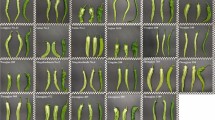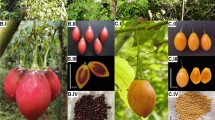Abstract
The hot peppers belonging to the species C. baccatum are completely restricted to Latin America and comprise the most popular hot pepper consumed as fresh or as processed paprika in Andean countries. The objective of this study was to characterize the phenotypic diversity among 40 landrace accessions of C. baccatum based on morphological fruit quality traits and yield components, and to determine the correlation between these characters and their contribution for the genetic variability. The accessions were analyzed for 14 fruit and plant descriptors. Plants were arranged as randomized complete block with three replicates. Collected data were initially subjected to analysis of variance and if the F-test was significant at P ≤ 0.01, the averages were grouped by Scott-Knott criteria. The heritability in a broad sense and phenotypic correlation were calculated. The phenotypic divergence and relative importance were estimated by multivariate analysis. Significant differences for all traits were observed by F-test (P ≤ 0.01). The range of heritability values were between 83.2 and 99.1. The landraces were grouped in seven different clusters. Major fruit width, fruit weight and fruit dry matter were the only fruit traits with positive correlation with yield. Plant width, height, first bifurcation height and fruit set were positive correlated between them and with yield. Based on the data, the most divergent accessions were 4 and 24, which could result in higher heterotic effect in eventual hybridizations between them. The results of this study showed that spice and vegetable type specific varieties can be developed from C. baccatum.
Similar content being viewed by others
References
Arunachalam V (1981) Genetic distance in plant breeding. Indian J Genet Plant Breed 41:226–236
Bosland PW (1993) Breeding for quality in Capsicum. Capsicum Eggplant Newsl 12:25–31
Bosland, PW and Votava EJ (2000) PEPPERS: vegetable and spice capsicums, 204. CABI Publishing
Cruz CD (2001) Programa GENES, aplicativo computacional em genética e estatística. Editora UFV, Viçosa 648 p
DeWitt D, Bosland PW (1996) Peppers of the world: an identification guide. Ten Speed press, Bekerley
Geleta LF, Labuschagne MT, Viljoen CD (2004) Relationship between heterosis and genetic distance based on morphological traits and AFLP markers in pepper. Plant Breed 123:467–473
Gill HS, Asawa BM, Thakur PC (1977) Correlation, path-coefficient and multiple regression analysis in sweet pepper. Indian J Agric Sci 47(8):408–410
Gopalakrishnan TR, Nari CSJ, Josh S, Peter KV (1985) Studies on yield attributes in chilli. Indian Cocoa, Arecanut Spices J VIII(3):72–73
Gupta CR, Yadav RDS (1984) Genetic variability and path analysis in chilli (Capsicum annuum Linn.). Genetica Agrária 38:425–432
INTERNATIONAL BOARD FOR PLANT GENETIC RESOURCES. IBPGR (1983) Genetics resources of Capsicum, a global plan and action. 49. Rome, IBPGR
INTERNATIONAL PLANT GENETIC RESOURCES INSTITUTE. IPGRI (1995) Descriptors for capsicum. Rome, IBPGRI,. 49 p
Lannes SD, Finger FL, Schuelter AR, Casali VWD (2007) Growth and quality of Brazilian accessions of capsicum chinense fruits. Sci Hortic 112(2007):266–270
Lee YM, Shin DY (1989) Genetic analysis of quantitative characters in diallel crosses of pepper (Capsicum annuum L.). Korean J Genet Plant Breed 21(2):138–142
Lefebvre V, Palloix A, Rves M (1993) Nuclear RFLP between pepper cultivars (Capsicum annuum L.). Euphytica 71:189–199
Legg PD, Lippert LF (1966) Estimates of genetic and environmental variability in a cross between two strains of pepper (Capsicum annuum L.). Proc Am Soc Hortic Sci 89:443–448
Manju PR, Sreelathakumary I (2002) Genetic variability, heritability and genetic advance in hot chilli (Capsicum chinense). J. Trop. Agric 40:4–6
Pickersgill B (1984) Migrations of Chilli Peppers, Capsicum spp., in the Americas. In: Stone D (ed) Pre-columbian plant migration. Papers of the peabody museum of archaeology and ethnology. Harvard University Press, Cambridge, MA, pp 105–123
Pinto CMF, Salgado LT, Picanço M, Paula Júnior TJ, Moura WM, Brommonschenkel SH (1999) A cultura da pimenta (Capsicum sp.), Boletim técnico n° 56, Belo Horizonte
Poulos JM (1994) Pepper breeding (Capsicum spp.): achievements, challenges and possibilities. Plant Breed Abstr 64(2):144–155
Prince JP, Loaiaza-Figueroa F, Tanksley SD (1992) Restriction fragment length polymorphism and genetic distance among Mexican accessions of Capsicum. Genome 35:726–732
Ramana Rao VV, Jaisani BG, Patel GJ (1974) Interrelationship and path coefficients of quantitative traits in chilli. Indian J Agric Sci 44(7):462–465
Rao AV (1952) Advanced statistical methods in biometrics research. Wiley, New York
Rêgo ER, Rêgo MM, Cruz CD, Cecon PR, Amaral DSSL, Finger FL (2003) Genetic diversity analysis of peppers: a comparison of discarding variable methods. Crop Breed Appl Biotech 3(1):19–26
Rêgo ER, Rêgo MM, Cruz CD, Finger FL, Casali VWD (2009) A diallel study of yield components and fruit quality in chilli pepper (Capsicum baccatum). Euphytica (Wageningen) 168:275–287
Rodriguez-Burruezo A, Prohens j, Raigón MD, Nuez F (2009) Variation for bioactive compounds in ají (Capsicum baccatum L.) and rocoto (C. pubescens R & P) and implications for breeding. Euphytica 170:169–181
Shifriss C, Zacks J, Goldman X (1989) Some notes on the association between fruit dimensions and fruit weight in Capsicum annuum L. Euphytica 43:275–277
Singh D (1981) The relative importance of characters affecting genetic divergence. Indian J Genetics & Plant Breed 41:237–245
Singh A, Singh HN (1977) Note on heritability, genetic advance and minimum number of genes in chilli. Indian J Agric Sci 47(5):260–262
Souza JA, Maluf WR (2003) Diallel analyses and estimation of genetic parameters of hot pepper (Capsicum chinense Jacq). Scientia Agricola 60:105–113
Sreelathakumary I, Rajamony L (2004) Variability, heritability and genetic advance in chilli (Capsicum annuum). J Tropical Agric 42:35–37
Acknowledgments
The work was supported in part by a grant from CNPQ and CAPES. The authors fellowships were provided by CNPq.
Author information
Authors and Affiliations
Corresponding author
Rights and permissions
About this article
Cite this article
Rêgo, E.R.d., Rêgo, M.M.d., Cruz, C.D. et al. Phenotypic diversity, correlation and importance of variables for fruit quality and yield traits in Brazilian peppers (Capsicum baccatum). Genet Resour Crop Evol 58, 909–918 (2011). https://doi.org/10.1007/s10722-010-9628-7
Received:
Accepted:
Published:
Issue Date:
DOI: https://doi.org/10.1007/s10722-010-9628-7





